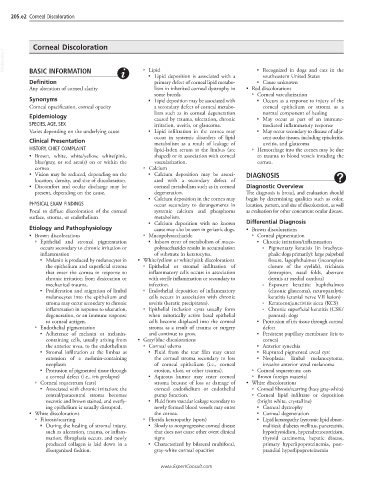Page 462 - Cote clinical veterinary advisor dogs and cats 4th
P. 462
205.e2 Corneal Discoloration
Corneal Discoloration
VetBooks.ir
○ Lipid
BASIC INFORMATION
southeastern United States
■ Lipid deposition is associated with a ■ Recognized in dogs and cats in the
Definition primary defect of corneal lipid metabo- ■ Cause unknown
Any alteration of corneal clarity lism in inherited corneal dystrophy in • Red discolorations
some breeds. ○ Corneal vascularization
Synonyms ■ Lipid deposition may be associated with ■ Occurs as a response to injury of the
Corneal opacification, corneal opacity a secondary defect of corneal metabo- corneal epithelium or stroma as a
lism such as in corneal degeneration normal component of healing
Epidemiology caused by trauma, ulceration, chronic ■ May occur as part of an immune-
SPECIES, AGE, SEX irritation, uveitis, or glaucoma. mediated inflammatory response
Varies depending on the underlying cause ■ Lipid infiltration in the cornea may ■ May occur secondary to disease of adja-
occur in systemic disorders of lipid cent ocular tissues, including episcleritis,
Clinical Presentation metabolism as a result of leakage of uveitis, and glaucoma
HISTORY, CHIEF COMPLAINT lipid-laden serum at the limbus (arc ○ Hemorrhage into the cornea may be due
• Brown, white, white/yellow, white/pink, shaped) or in association with corneal to trauma to blood vessels invading the
blue/gray, or red area(s) on or within the vascularization. cornea.
cornea ○ Calcium
• Vision may be reduced, depending on the ■ Calcium deposition may be associ- DIAGNOSIS
location, density, and size of discoloration. ated with a secondary defect of
• Discomfort and ocular discharge may be corneal metabolism such as in corneal Diagnostic Overview
present, depending on the cause. degeneration. The diagnosis is broad, and evaluation should
■ Calcium deposition in the cornea may begin by determining qualities such as color,
PHYSICAL EXAM FINDINGS occur secondary to derangements in location, pattern, and size of discoloration, as well
Focal to diffuse discoloration of the corneal systemic calcium and phosphorus as evaluation for other concurrent ocular disease.
surface, stroma, or endothelium metabolism.
■ Calcium deposition with no known Differential Diagnosis
Etiology and Pathophysiology cause may also be seen in geriatric dogs. • Brown discolorations
• Brown discolorations ○ Mucopolysaccharide ○ Corneal pigmentation
○ Epithelial and stromal pigmentation ■ Inborn error of metabolism of muco- ■ Chronic irritation/inflammation
occurs secondary to chronic irritation or polysaccharides results in accumulation ❏ Pigmentary keratitis (in brachyce-
inflammation of substrate in keratocytes. phalic dogs primarily): large palpebral
Melanin is produced by melanocytes in • White/yellow or white/pink discolorations fissure, lagophthalmos (incomplete
■
the epithelium and superficial stroma ○ Epithelial or stromal infiltration of closure of the eyelids), trichiasis
that enter the cornea in response to inflammatory cells occurs in association (entropion, nasal folds, aberrant
chronic irritation from desiccation or with sterile inflammation or secondary to dermis at medial canthus)
mechanical trauma. infection. ❏ Exposure keratitis: buphthalmos
Proliferation and migration of limbal ○ Endothelial deposition of inflammatory (chronic glaucoma), neuroparalytic
■
melanocytes into the epithelium and cells occurs in association with chronic keratitis (cranial nerve VII lesion)
stroma may occur secondary to chronic uveitis (keratic precipitates). ❏ Keratoconjunctivitis sicca (KCS)
inflammation in response to ulceration, ○ Epithelial inclusion cysts usually form ❏ Chronic superficial keratitis (CSK/
degeneration, or an immune response when mitotically active basal epithelial pannus): dogs
to corneal antigen. cells become displaced into the corneal ■ Protrusion of iris tissue through corneal
○ Endothelial pigmentation stroma as a result of trauma or surgery defect
Adherence of melanin or melanin- and continue to grow. Persistent pupillary membrane (iris to
■ ■
containing cells, usually arising from • Gray/blue discolorations cornea)
the anterior uvea, to the endothelium ○ Corneal edema ■ Anterior synechia
Stromal infiltration at the limbus as Fluid from the tear film may enter Ruptured pigmented uveal cyst
■ ■ ■
extension of a melanin-containing the corneal stroma secondary to loss ■ Neoplasia: limbal melanocytoma,
neoplasm of corneal epithelium (i.e., corneal invasive anterior uveal melanoma
Protrusion of pigmented tissue through erosion, ulcer, or other trauma). ○ Corneal sequestrum: cats
■
a corneal defect (i.e., iris prolapse) ■ Aqueous humor may enter corneal ○ Brown foreign material
○ Corneal sequestrum (cats) stroma because of loss or damage of • White discolorations
Associated with chronic irritation: the corneal endothelium or endothelial ○ Corneal fibrosis/scarring (hazy gray-white)
■
central/paracentral stroma becomes pump function. ○ Corneal lipid infiltrate or deposition
necrotic and brown stained, and overly- ■ Fluid from vascular leakage secondary to (bright white, crystalline)
ing epithelium is usually disrupted. newly formed blood vessels may enter ■ Corneal dystrophy
• White discolorations the cornea. ■ Corneal degeneration
○ Fibrosis/scarring ○ Florida keratopathy (spots) ■ Lipid keratopathy (systemic lipid abnor-
During the healing of stromal injury, Slowly to nonprogressive corneal disease malities): diabetes mellitus, pancreatitis,
■ ■
such as ulceration, trauma, or inflam- that does not cause other overt clinical hypothyroidism, hyperadrenocorticism,
mation, fibroplasia occurs, and newly signs thyroid carcinoma, hepatic disease,
produced collagen is laid down in a ■ Characterized by bilateral multifocal, primary hyperlipoproteinemia, post-
disorganized fashion. gray-white corneal opacities prandial hyperlipoproteinemia
www.ExpertConsult.com

